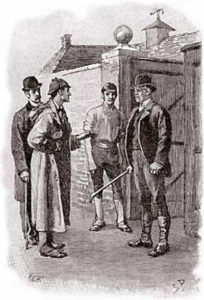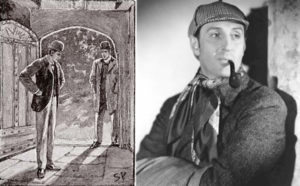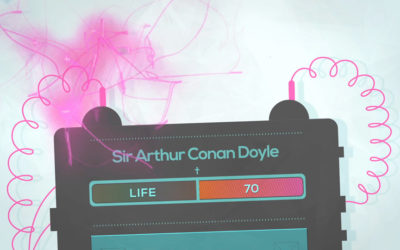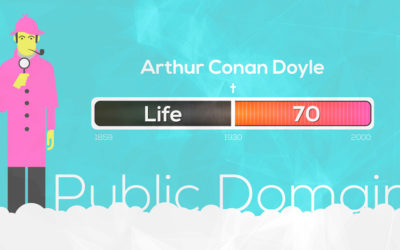Copyright Bite #1.3
 Interestingly, Holmes is never described as wearing a deerstalker hat, although in The Adventure of Silver Blaze Watson does refer to Holmes wearing an ‘ear-flapped travelling cap’. Sidney Paget (1860-1908), the artist who first illustrated Conan Doyle’s short stories, does depict Holmes wearing a deerstalker in Silver Blaze, but the deerstalker actually only features in eight of Doyle’s short stories as they appeared in The Strand Magazine. By contrast, Holmes is illustrated in 34 other stories wearing different types of hat, whether a silk top hat, a bowler or a fedora.
Interestingly, Holmes is never described as wearing a deerstalker hat, although in The Adventure of Silver Blaze Watson does refer to Holmes wearing an ‘ear-flapped travelling cap’. Sidney Paget (1860-1908), the artist who first illustrated Conan Doyle’s short stories, does depict Holmes wearing a deerstalker in Silver Blaze, but the deerstalker actually only features in eight of Doyle’s short stories as they appeared in The Strand Magazine. By contrast, Holmes is illustrated in 34 other stories wearing different types of hat, whether a silk top hat, a bowler or a fedora. Indeed, the myth and persona of Holmes is defined not just by Doyle or Paget but by the enormous number of adaptations and abridgements, television programmes and films that have contributed to the legacy and enduring appeal of Doyle’s greatest creation. Holmes even features in the Guinness Book of Records as the most portrayed literary human character in film and TV. He has been depicted on screen over 250 times, played by more than 75 actors including Sir Christopher Lee, Sir Ian McKellen, Peter Cook and Robert Downey Jr.
Indeed, the myth and persona of Holmes is defined not just by Doyle or Paget but by the enormous number of adaptations and abridgements, television programmes and films that have contributed to the legacy and enduring appeal of Doyle’s greatest creation. Holmes even features in the Guinness Book of Records as the most portrayed literary human character in film and TV. He has been depicted on screen over 250 times, played by more than 75 actors including Sir Christopher Lee, Sir Ian McKellen, Peter Cook and Robert Downey Jr.More from Bite #1
Copyright Bite #1.1
Copyright does not last forever. In the UK, and across Europe, copyright in books, plays, music, works of art and films comes to an end 70 years after the author’s death.
Copyright Bite #1.2
Knowing that copyright generally lasts for the lifetime of the author plus 70 years is a useful rule of thumb, although this rule does not apply to all types of copyright work.
Copyright Bite #1.4
Having become tired of his famous creation, Conan Doyle decided to kill him off in 1893.
Copyright Bite #1.5
Once an author’s body of work enters the public domain it is free to be re-used by anyone.
Copyright Bite #1.6
When most people discuss copyright in a work coming to an end, they talk about the work falling into the public domain. The metaphor of ‘the fall’ carries a number of – mostly negative – connotations.
More Copyright Bites
Copyright Bite #1
Copyright Bite #1 considers how long copyright lasts and what it means to say that a work is protected by copyright or in the public domain.
Copyright Bite #2
Copyright Bite #2 explores how copyright protects only the expression of ideas and not ideas themselves.
Copyright Bite #3
Copyright Bite #3 considers how you can lawfully make use of, or borrow from, works that are still in copyright, but without having to ask for permission or make payment to the copyright owner.
Copyright Bites Credits
Copyright Bites: Credits and Acknowledgements

















